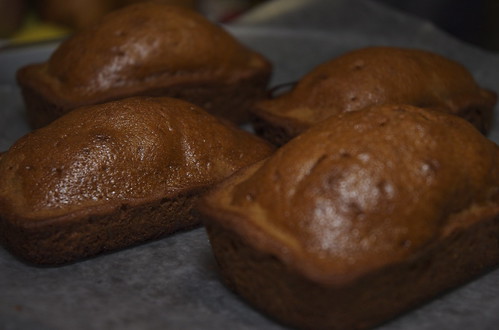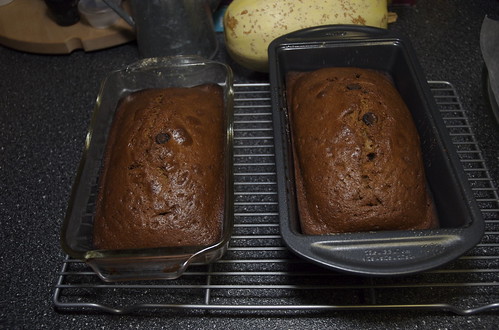
Cook's Illustrated Magazine and cooksillustrated.com are among my favorite food publications and resources. I like their methods. It comforts me to know that they systematically tried a thousand different variations in order to find the best way, and I like how their articles break down the science behind why certain things work and certain things do not. I don't know, it makes me want to wear a lab coat.
Anyway, this holiday season, CI introduced their new recipe for a Foolproof Pie Dough - one that is easy to manipulate without it falling apart on you while you roll it out, but one that is as buttery and flaky as any pie crust you could ever want. The secret is alcohol! Something about gluten reacting with something, I forget. But if you add ice cold vodka to your pie crust, it allows the dough to become nice and supple without causing the result to be tough and gross.
Guys. This was like rolling out cookie dough. It was so easy that I was skeptical it would taste good. I used the two-crust recipe (below) to make an Apple-Cranberry Pie and the one-crust recipe to make a Pumpkin Pie. I'm the youngest of like a hundred siblings and they love to make fun of everything I do, no matter what, so I was amazed when all of them only said things like "Wow!" and "Oh my God!" and "This is so perfect!" at Thanksgiving. How do you make a light, flaky, melt-in-your-mouth pie crust that didn't rip a thousand times as you try to maneuver it onto the pie plate? BOOZE!
(Note: It is certainly possible that some of you guys have never had any trouble with pie crust dough, but I'm just saying. Why not make things easier for everyone? Also, in case you are worried that I got my little nieces illegally wasted on vodka, the alcohol bakes off in the oven, and you can't taste a thing!)
Foolproof Pie Dough for a Two-Crust Pie (1 9" two-crust pie)
(The secret here is to really trust their amounts and times. Things will seem weird to you because certain visual and textural cues won't be like you remember them, but just go with it. I promise.)
| 2 1/2 | cups unbleached all-purpose flour (12 1/2 ounces) |
| 1 | teaspoon table salt |
| 2 | tablespoons sugar |
| 12 | tablespoons cold unsalted butter (1 1/2 sticks), cut into 1/4-inch slices |
| 1/2 | cup chilled solid vegetable shortening , cut into 4 pieces |
| 1/4 | cup vodka , cold |
| 1/4 | cup cold water |
1. Process 1 1/2 cups flour, salt, and sugar in food processor until combined, about 2 one-second pulses. Add butter and shortening and process until homogenous dough just starts to collect in uneven clumps, about 15 seconds (dough will resemble cottage cheese curds and there should be no uncoated flour). Scrape bowl with rubber spatula and redistribute dough evenly around processor blade. Add remaining cup flour and pulse until mixture is evenly distributed around bowl and mass of dough has been broken up, 4 to 6 quick pulses. Empty mixture into medium bowl.
2. Sprinkle vodka and water over mixture. With rubber spatula, use folding motion to mix, pressing down on dough until dough is slightly tacky and sticks together. Divide dough into two even balls and flatten each into 4-inch disk. Wrap each in plastic wrap and refrigerate at least 45 minutes or up to 2 days.
For one 9" Single-Crust Pie
| 1 1/4 | cups unbleached all-purpose flour (6 1/4 ounces) |
| 1/2 | teaspoon table salt |
| 1 | tablespoon sugar |
| 6 | tablespoons cold unsalted butter (3/4 stick), cut into 1/4-inch slices |
| 1/4 | cup chilled solid vegetable shortening , cut into 2 pieces |
| 2 | tablespoons vodka , cold |
| 2 | tablespoons cold water |
1. Process 3/4 cups flour, salt, and sugar together in food processor until combined, about 2 one-second pulses. Add butter and shortening and process until homogenous dough just starts to collect in uneven clumps, about 10 seconds (dough will resemble cottage cheese curds with some very small pieces of butter remaining, but there should be no uncoated flour). Scrape down sides and bottom of bowl with rubber spatula and redistribute dough evenly around processor blade. Add remaining 1/2 cup flour and pulse until mixture is evenly distributed around bowl and mass of dough has been broken up, 4 to 6 quick pulses. Empty mixture into medium bowl.
2. Sprinkle vodka and water over mixture. With rubber spatula, use folding motion to mix, pressing down on dough until dough is slightly tacky and sticks together. Flatten dough into 4-inch disk. Wrap in plastic wrap and refrigerate at least 45 minutes or up to 2 days.
3. Adjust oven rack to lowest position, place rimmed baking sheet on oven rack, and heat oven to 425 degrees. Remove dough from refrigerator and roll out on generously floured (up to ¼ cup) work surface to 12-inch circle about 1/8 inch thick. Roll dough loosely around rolling pin and unroll into pie plate, leaving at least 1-inch overhang on each side. Working around circumference, ease dough into plate by gently lifting edge of dough with one hand while pressing into plate bottom with other hand. Leave overhanging dough in place; refrigerate until dough is firm, about 30 minutes.
4. Trim overhang to ½ inch beyond lip of pie plate. Fold overhang under itself; folded edge should be flush with edge of pie plate. Flute dough or press the tines of a fork against dough to flatten it against rim of pie plate. Refrigerate dough-lined plate until firm, about 15 minutes.
5. Remove pie pan from refrigerator, line crust with foil, and fill with pie weights or pennies. Bake for 15 minutes. Remove foil and weights, rotate plate, and bake for 5 to 10 minutes additional minutes until crust is golden brown and crisp.
***************************************
The Apple Cranberry Pie was something special also. Here's the recipe and some pics. I'd never made such an attractive two-crust pie in my life.
Apple-Cranberry Pie (from Cook's Illustrated)
Use sweet, crisp apples, such as Golden Delicious, Jonagold, Fuji, or Braeburn. The two fillings can be made ahead, cooled, and stored separately in the refrigerator for up to 2 days.
Makes one 9-inch pie
| 2 | cups fresh or frozen cranberries |
| 1/4 | cup orange juice |
| 1 | cup granulated sugar (7 ounces) plus 1 tablespoon for top of pie |
| 1/2 | teaspoon ground cinnamon |
| 1/2 | teaspoon table salt |
| 1/4 | cup water |
| 1 | tablespoon cornstarch |
| 3 1/2 | pounds sweet apples (6 to 7 medium), peeled, cored, and cut into 1/4-inch-thick slices (see note above) |
| 1 | recipe pie dough (see related recipe) |
| 1 | egg white , beaten lightly |
1. Bring cranberries, juice, 1/2 cup sugar, 1/4 teaspoon cinnamon, and 1/4 teaspoon salt to boil in medium saucepan over medium-high heat. Cook, stirring occasionally and pressing berries against side of pot, until berries have completely broken down and juices have thickened to jamlike consistency (wooden spoon scraped across bottom should leave clear trail that doesn't fill in), 10 to 12 minutes. Remove from heat, stir in water, and cool to room temperature, about 30 minutes.


2. Meanwhile, mix 1/2 cup sugar, remaining 1/4 teaspoon cinnamon, remaining 1/4 teaspoon salt, and cornstarch in large microwave-safe bowl; add apples and toss to combine. Microwave on high power, stirring with rubber spatula every 3 minutes, until apples are just starting to turn translucent around edges and liquid is thick and glossy, 10 to 14 minutes. Cool to room temperature, about 30 minutes.
3. While fillings cool, adjust oven rack to lowest position, place rimmed baking sheet on oven rack, and heat oven to 425 degrees. Remove 1 disk of dough from refrigerator and roll out on generously floured (up to 1/4 cup) work surface to 12-inch circle about 1/8 inch thick. Roll dough loosely around rolling pin and unroll into pie plate, leaving at least 1-inch overhang. Ease dough into plate by gently lifting edge of dough with one hand while pressing into plate bottom with other hand. Leave dough that overhangs plate in place; refrigerate until dough is firm, about 30 minutes.
4. Transfer cooled cranberry mixture to dough-lined pie plate and spread into even layer. Place apple mixture on top of cranberries, mounding slightly in center; push down any sharp apple edges.
5. Roll second disk of dough on generously floured work surface (up to 1/4 cup) to 12-inch circle about 1/8 inch thick. Roll dough loosely around rolling pin and unroll over pie, leaving at least 1-inch overhang on each side.
6. Using kitchen shears, cut evenly through both layers of overhanging dough, leaving 1/2-inch overhang. Fold dough under itself so that edge of fold is flush with outer rim of pie plate. Flute edges using thumb and forefinger or press with tines of fork to seal. Brush top and edges of pie with egg white and sprinkle with remaining tablespoon sugar. Using sharp paring knife, cut four 1 1/2-inch slits in top of dough in cross pattern.
7. Place pie on preheated baking sheet and bake until top is light golden brown, 20 to 25 minutes. Reduce oven temperature to 375 degrees, rotate baking sheet, and continue to bake until crust is deep golden brown, 25 to 30 minutes longer. Transfer pie to wire rack to cool at least 2 hours. Cut into wedges and serve.

In the oven!
********************
I'm not just saying this because I'm worried I'll get busted for reproducing their recipes, but the $20 annual fee to join cooksillustrated.com has been the best $20 I've ever spent. They have instructional videos for practically everything, and equipment ratings that have already saved me a bunch of money (I used to just buy the most expensive version of everything, but now I know to do my research first). Plus they have a weekly newsletter that is both non-intrusive and inspiring every single week.
(My siblings now call the pie "Vodka Pie," but the tones in their voices sound awestruck, not sneering. Thank you, Cook's Illustrated. Thank you.)



















